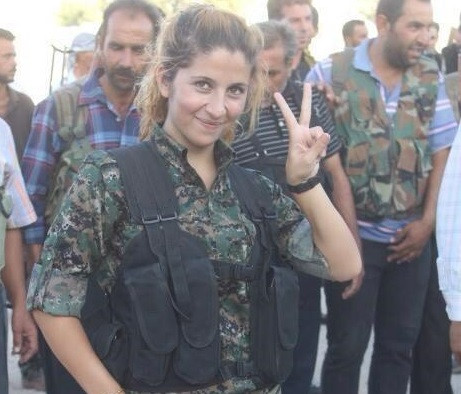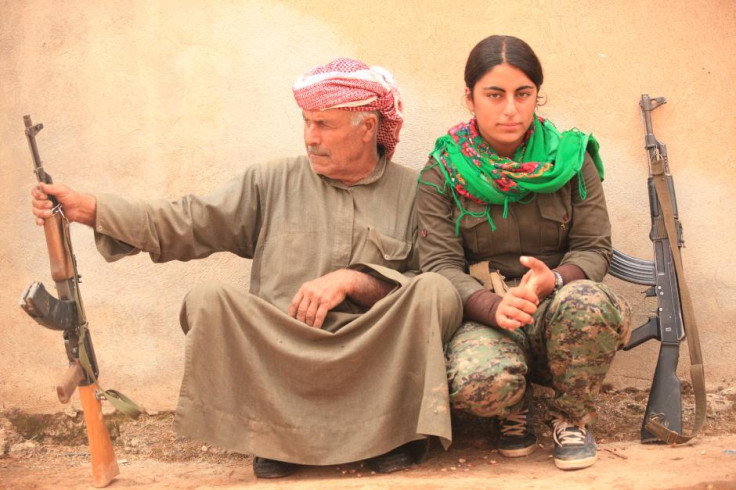Rehana the 'Angel of Kobani': Social Media Myths in the War Against Isis Terror

The old saying "truth is the first casualty of war" springs to mind with the story of Kurdish jihadi-slayer "Rehana" - a woman who reportedly killed 100 Islamic State (IS) fighters but who may well be a ghost.
Rehana leapt to prominence during the battle for the Syrian city of Kobani, when a photo of a smiling woman giving the peace sign went viral on the web. One hundred IS fighters had been killed by Rehana alone, it was claimed. Her exploits were reported by titles everywhere including the Daily Mail, the Mirror and IBTimes.co.uk.
For Kurds, Rehana is a heavily armed "Angel of Kobani" - symbol of their defiance against the existential threat of IS, currently menacing their way of life. Her image was published on Twitter with the caption: "RT [retweet] and make her famous for bravery."

But to the far away Western media, Rehana symbolises something very different: the difficulty of verification.
The problem with an angel such as Rehana is there is next to nothing about her that can be confirmed with a high degree of certainty.
Her story echoes wartime myths such as the Angels of Mons, which reportedly protected British soldiers in 1914, and other legendary figures like Lei Feng, the mostly made-up hero of Chinese communists under Chairman Mao.
In the anniversary year of the First World War, could Rehana be the digital age's own version of that age-old phenomenon: wartime myth-making? It would not be a surprise, as war and myths go together like guns and bullets.
Using 'partial truths' to shape a situation
Historian and writer Andy Robertshaw believes such figures play an important role in time of war. They may not be living, breathing people he said, but their impact is real.
Robertshaw told IBTimes UK: "In times of national emergency this helps people to feel rather better about what is happening. It's a way of seizing partial truths and making them fit your needs in the moment.
In times of national emergency this helps people to feel rather better about what is happening. It helps undermine a whole cause and that's very important
"It tells the Kurds they have got an ace on their side - which is nice to know. It's also a way of making the jihadis uncomfortable because they believe they won't to go to heaven if she kills them.
"So it helps undermine a whole cause and that's very important. This is similar to the idea of the Mons Angels helping the Allies. It's saying: 'We are right and the enemy is wrong because God is on our side.'"
Rehana certainly is an appealing antidote to the daily diet from Syria and Iraq of IS's "torrent of horror" – medieval barbarism prompted by religious intolerance, which is all broadcast on social media in stomach-churning high definition.
Amid the fog of war, Rehana appears a Kurdish folk hero whose feats contrast so sharply with stories of terrified Iraqi army officers fleeing their positions in the face of IS's bloody onslaught.
Then there is the point that Rehana is a woman; one who rubs IS's grubby nose right in its medieval attitude toward the female of the species. Killing 100 of the fundamentalist fighters – who apparently believe women should be neither seen nor heard – represents a galvanising slap in their face on behalf of progressives everywhere.
But myth and reality bump awkwardly up against each in this Angel of Kobani. Everything we know about Rehana comes from Kurdish media sources, meaning it all comes attached with a big, flashing bias warning.
Are we really looking at Rehana?
Here are the problems. We do not know if the woman in the now famous photograph really is Rehana – a credible-looking claim states the photo is of a female "Home Guard" fighter and not the crackshot of legend. We also do not know how many IS fighters Rehana has killed – 100 does seem like a suspiciously nice round number. We do not even know if Rehana is alive or dead.
Altogether, that is a lot of known unknowns.
In to this void of verified information has stepped propaganda. IS tweeted a typically gruesome image of a grinning man holding a woman's decapitated head, which it said is Rehana. The Kurds deny she is dead. This reporter was told by a Kurdish journalist that Rehana spoke just recently with a colleague - long after IS said it had killed her.
Verification is very difficult. In any campaign, like this war against IS, there are going to be people like Rehana held up as icons of the struggle
The story of Rehana is more than whether she is dead or alive and her impact in the battle for Korbane. It is also about the challenge of fact-checking for media in the age of Twitter and smart phones and the power of myth.
Myth is arguably as powerful today as ever because of how quickly content can travel via social media, straight to users' smart phones and mobile devices.
An old saying by Mark Twain seems pertinent here; that "a lie can travel halfway around the world while the truth is putting its shoes on".
The internet and consumer technology spawn a plethora of media outlets hosting a vast volume of eye-witness content submitted by users, watched by millions. IS understands all this very well indeed. So too do news firms which know their credibility depends upon being a reliable source for readers.
Deconstructing the myths to potentially reveal the reality
Storyful in Dublin, Ireland, is a news agency for the social media age. It stands up stories for publishers by sifting through this ocean of user-generated content. The war against Islamic State in Syria and Iraq is providing plenty of it.
Journalists there use a three-stage process involving electronic data and human boots on the ground to verify the claims of photos and video. It is a canny blend of modern consumer technology and old-fashioned journalistic rigour. Despite being laborious and time-consuming work, it is important. And somebody has to do it.
"Verification is very difficult," news editor Malachy Browne told IBTimes UK.

"In any campaign like this [war against IS] there are going to be people like Rehana held up as icons of the struggle.
"The Kurdish forces chose one fighter who is photogenic and that is part of their own propaganda campaign. And Isis is very adept at propaganda.
"Journalists are sceptical by nature and alarm bells were ringing when I read of a photogenic female fighter, armed to the teeth, who has dropped 100 fighters," he said.
"Unfortunately, we see in this desperate rush to provide coverage of what's going on in Kobani, that the media takes the propaganda bait.
"This has happened through the ages," said Browne. "In communist China there was Fei-Ling; this humble soldier who cared only for the state and the Communist party, who sacrificed his own life. It's believed now that Lei-Feng was a story which was twisted and re-twisted in to falsehood for Chairman Mao."
From Lei-Feng the selfless socialist in China, to sinister figures such as Percey Toplis of the First World War, so-called "composite personalities" keep cropping up during struggles in the hour of direst need. Some myths are so powerful they enter the national consciousness, such as the famous angels at Mons.
To the watching world, Rehana is a mysterious, unknown figure. For Kurds she is scaring IS fighters who fear they will be locked out of heaven if she kills them.
Whether Rehana and her feats are real or not, this Angel of Kobani is playing the role of a symbol of hope against the forces of darkness.
© Copyright IBTimes 2025. All rights reserved.






















